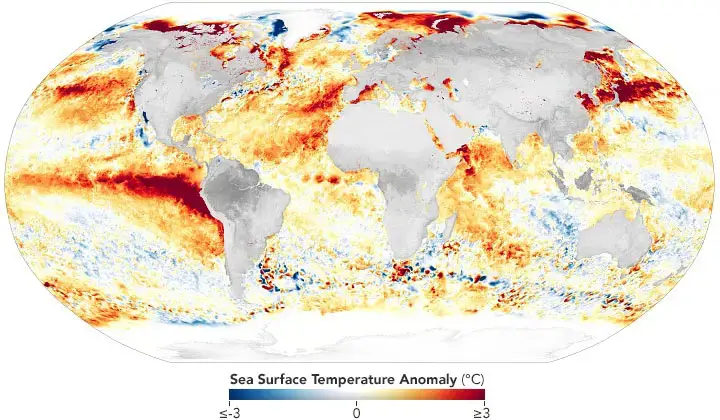Decades of gradual warming due to human-induced climate change and El Niño in the Pacific Ocean have pushed global ocean temperatures to record highs in 2023.
In March and April 2023, some scientists began noticing that average sea surface temperatures were exceeding the highest levels recorded in key data maintained by NOAA. Months later, global sea surface temperatures remain at record levels, hovering 0.99 °C (1.78 °F) above the July average. They reached record levels for the fourth month in a row.
growth factors
Scientists from NASA learned why this happened in more detail. “There are many things that affect global sea surface temperatures, but two main factors have pushed them to record levels,” said oceanographer Josh Willis at NASA’s Jet Propulsion Laboratory (JPL). “An El Niño is developing in the Pacific Ocean, and this is combined with long-term global warming that has steadily increased ocean temperatures almost everywhere over the course of a century.”
The map at the top of this article shows sea surface temperature anomalies on August 21, 2023, when many regions were 3°C (5.4°F) above normal. Much of the central and eastern equatorial Pacific was unusually warm that day, signaling the development of El Niño. As has been the case for several weeks, large patches of warm water have been present in the northwest Pacific near Japan and the northeast Pacific near California and Oregon. Parts of the Indian, Southern and Arctic Oceans also showed unusual temperatures.
Data and anomalies
The map is based on data from the Multi-Scale Ultra High Resolution Sea Surface Temperature (MUR SST) project, a JPL study combining sea surface temperature measurements from various NASA, NOAA and international satellites, as well as observations from ships and buoys. Instead of showing absolute temperature, the anomaly shows the difference between the sea surface temperature on August 21, 2023 and the 2003-2014 average for that date. Also based on MUR SST data, the video below shows global sea surface temperature since April 1, 2023, when it was at a record high. The warmest waters appear dark red.
Based on MUR SST data, this video shows global sea surface temperatures from April 1 to August 21, 2023, when they reached record highs. The warmest waters appear dark red.
“Long-term, we’re seeing higher temperatures and warmer sea surface temperatures almost everywhere,” said Gavin Schmidt, director of NASA’s Goddard Institute for Space Studies. “This long-term trend is almost entirely due to human influence, the fact that we have emitted such a large amount of greenhouse gases into the atmosphere since the beginning of the industrial age.”
unraveling the trends
Other factors, such as weather and wind patterns or the distribution of dust and aerosols, have short-term effects on sea surface temperatures in certain regions, but these tend to have little effect on the long-term global average, Schmidt said. Previous studies have shown that up to 90 percent of the excess heat generated in recent years due to increased greenhouse gas emissions has been absorbed by the oceans, with most of this heat being stored near the surface.
According to Willis, the most important factor helping sea surface temperatures rise to record levels in 2023 was the development of El Niño in the Pacific Ocean. He reached this conclusion by analyzing the timing and intensity of sea surface temperature anomalies in various regions and comparing them to the global trend.
“In early April, when temperatures in the Pacific Ocean increased and at the same time sea level began to rise in the eastern Pacific Ocean, we had a huge jump in global surface temperature,” Willis said. said. “Atlantic heatwaves are significant and will have a major impact on marine life and weather in Europe in the months ahead. But this year the Pacific has caught up with the global average.”
What goes on in the Pacific Ocean tends to have a large impact on global sea surface temperatures, partly because of its size. The Pacific Ocean is about half the size of the world’s oceans.
sea heat waves
Marine heatwaves, defined as periods when ocean temperatures are consistently abnormally high (higher than 90 percent of previous observations for that period of the year), have recently occurred in many regions. A NOAA analysis found that in August 48 percent of the world’s oceans were at the center of the maritime heatwave; This is a larger area than has been seen in any month since records began in 1991. Particularly intense events have warmed the North Atlantic and its regions. in the Caribbean basin in recent months.
Willis expects the equatorial Pacific heatwave to be more persistent than many other marine heatwaves simmering around the world. “Most of the marine heat waves we observe are transient and deep, usually lasting for weeks, and are caused by atmospheric forcing,” Willis explained.
Unusually warm water in the Equatorial Pacific associated with the development of El Niño after three consecutive years of La Niña is expected to weaken trade winds and further strengthen El Niño, which will intensify and intensify the warming of surface waters. Forecasters at NOAA say the El Niño is more than 95 percent likely to continue through the Northern Hemisphere winter. “What happens with El Niño in the Pacific will affect global weather patterns and sea surface temperatures throughout the winter and possibly longer,” Willis said.
Monitoring tools and result
NOAA and NASA scientists are analyzing observations from sensors and buoys in the oceans, ships, and several different polar orbiting and geostationary satellites to monitor sea surface temperatures. Teams of scientists from NOAA’s Physical Sciences Laboratory, NOAA’s Coral Reef Observatory, and NASA’s Jet Propulsion Laboratory closely monitor marine heat waves and sea surface temperature anomalies. You can use NASA’s State of the Ocean tool in Worldview to track daily sea surface temperature anomalies. Source
Source: Port Altele
